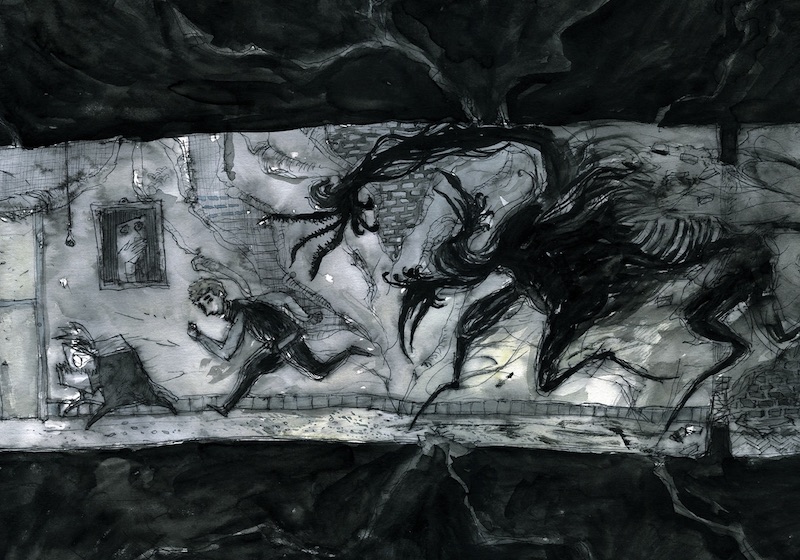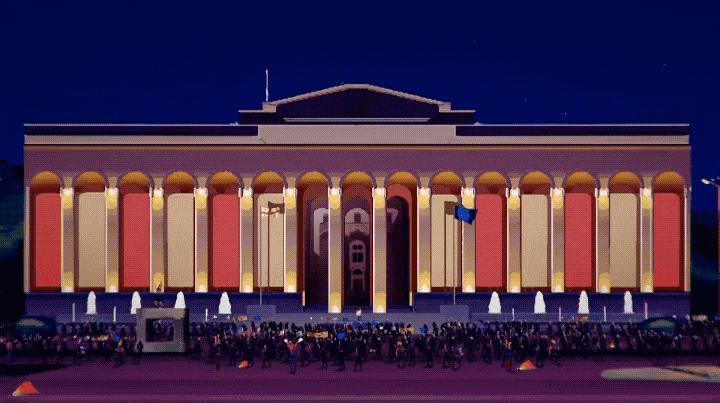Inside Creaks, a video game world inspired by Czech Cubism

Against a backdrop of decaying libraries, untidy desks, and peeling wallpaper, platform-adventure game Creaks begins as an earthquake shakes the foundations of a crumbling mansion: breaking floors, smashing lightbulbs, and revealing an underground world below.
Alive with surreal monsters, lab experiments, and sinister paintings, the game — available on Apple Arcade, Steam PS4, Xbox One, and the Nintendo Switch, via Czech indie software firm, Amanita Design — is dark and utterly immersive, with a unique aesthetic of stained watercolours and line-drawn book illustrations.
Looking for inspiration on your doorstep may seem strange for a game that features bird people, robot dogs, and furniture monsters
“I enjoy seeing a little bit of dirt in a game’s visuals,” admits Radim Jurda, Creaks lead designer and artist. “I wanted the place to feel fantastical yet believable, to make it feel like someone’s lived there. The shapes of the caves you can see at the beginning of Creaks are inspired by some rocks in the woods near our countryside house in Lipnice nad Sázavou.”
Looking for inspiration on your doorstep may seem strange for a game that features bird people, robot dogs, and furniture monsters, but Jurda’s influences are as eclectic as they are plentiful — ranging from cubist architect Josef Gočár, to stop-motion director Jiří Barta.
Together, it’s these influences which make Creaks unique from other platform games, which often have a bright cinematic feel. Instead, the game feels more MC Escher than Pixar blockbuster, with the player controlling a clumsy everyman character who reluctantly explores the abandoned Victorian-style house using rickety ladders to descend into the game’s underworld. Your goal is to rescue paintings from the depths of the house, each crafted by Creaks co-creator Jan Chlup. It is unsettling to journey into the unknown, but Creaks’ measured pace allows you to eventually adjust to the uneasy atmosphere.
Concept art for Creaks.
But that unease isn’t just created by the lurking prospect of monsters: it permeates everything in the game, from the lighting to the furniture.
“I was mostly inspired by Gočár’s interior design and his cubist furniture,” says Jurda. The designer is behind several landmarks in Prague, such as the House of the Black Madonna with its Escher-like staircases and huge dormer windows.
“We used cubistic morphology for the shapes of rooms and ladder frames. We’ve also got a built-in version of Gočár’s wardrobe in our game. We decided to use the architecture of the 19th and early 20th centuries as a source of inspiration for the interiors. That’s the period when electricity was new, and lamplight still felt magical.”
This era of early domestic electricity is borne out in Creaks’ subtle shading that is brought to life by flickering lightbulbs which is a stark contrast to the outdoor gloom. The off-kilter nature of the setting isn’t a flimsy novelty. There’s a very measured reason why the action starts in the attic of a large mansion continuing into a basement where surreal creatures have to be avoided and works of art acquired — the house is far more than just a mansion.
“We used the house as a metaphor for the subconsciousness,” says Jurda. “The collectible paintings are often more vivid in comparison to the interiors, capturing what’s happened outside. Metaphorically speaking, these paintings are like windows that allow us to see outside of this dark world.”
A screenshot from Creaks
Jurda’s ability to marry beautiful aesthetics with logic-driven puzzles has deep roots. Throughout his childhood, Jurda’s father was obsessed with design magazines, while his mother founded an electrical engineering company.
“She designed printed circuit boards,” Jurda adds. “Which is a puzzle game in itself. It’s something I inherited from my parents: logical thinking from my mum and my dad’s sense of art. My mum says I had decided to make art my profession when I was about four years old, and I’ve been on that path all my life.”
His early years also included making board games. His very first was almost a template for Creaks, with the idea of a central mansion proving to be a leitmotif of his work.
Seemingly disparate, these snatched pieces of Jurda’s past each feed into the game’s central theme — delving into our own often unacknowledged subconscious
“It was a simple roll and move board game where you roll the dice and see what happens,” he says. “The gameplay was not very good, but the mysterious island theme stuck with me.”
The atmosphere and aesthetics for Creaks can meanwhile be found in Jurda’s teenage years. Much is owed to the work of Czech animator Jiří Barta, whose own delicately carved wooden puppets look very similar to the bird people and carpet monsters seen in Creaks.
Jurda admits he was “blown away” by the atmosphere of Barta’s 1986 filmThe Pied Piper when he saw it for the first time, to the point where he became Barta’s student after he finished high school. The experience left an indelible mark on Jurda.
A collectable painting from Creaks
“I felt like I was on the same wavelength with him,” the 35-year-old says. “So I decided to apply for his animation studio, even though I had no animation experience at the time. I thought we shared a similar sense of poetics and humour, and he was very patient with me as I struggled to create scenarios for my first animation projects.”
Seemingly disparate, these snatched pieces of Jurda’s past each feed into the game’s central theme — delving into our own often unacknowledged subconscious, or our childhood sense of freedom. As players descend, they are not only delving into the designers’ mind, but also, often thanks to the game’s eerie soundtrack created by Joe Acheson’s Hidden Orchestra, into their own.
“The topic of imagination plays a big part in the game,” says Jurda. “It shows that the dark monsters don’t necessarily have to be the bad guys and that to progress we must combine both the real world and the gloomy imaginative world.”


